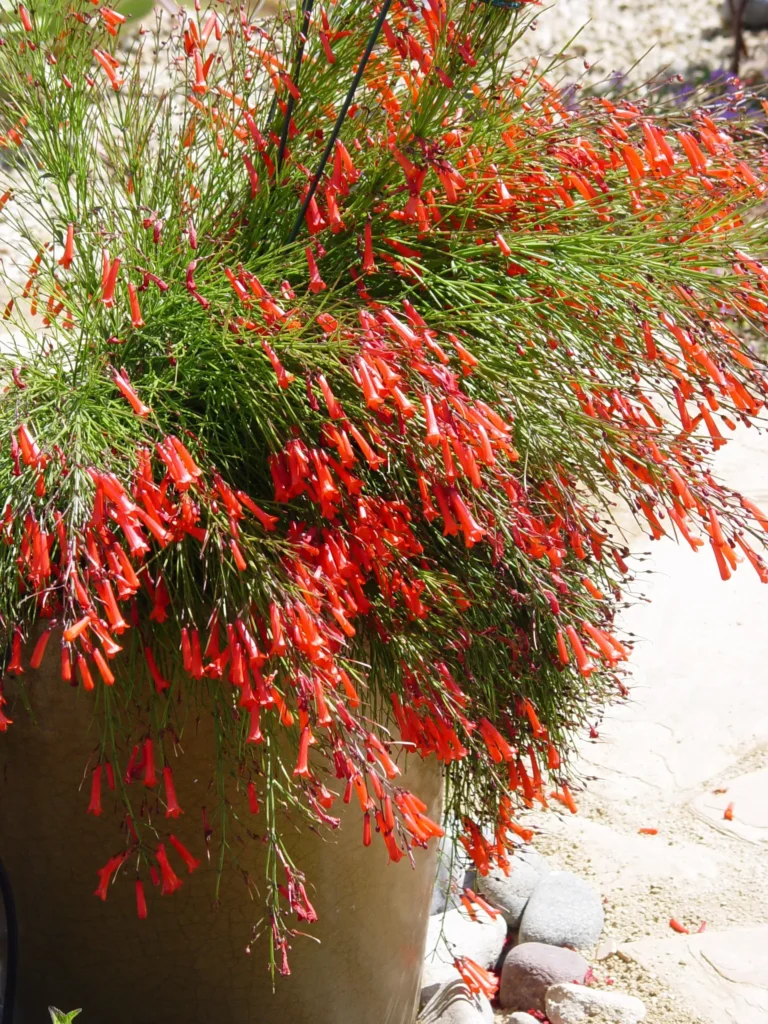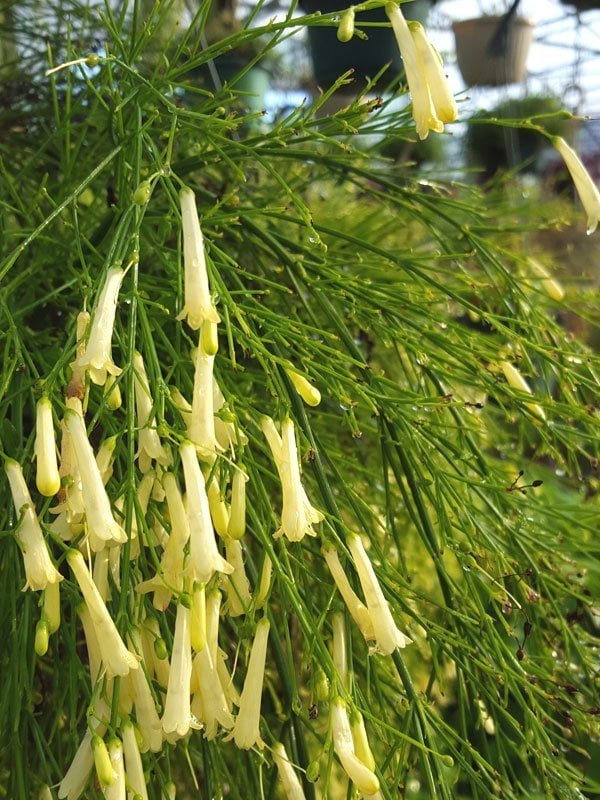If you’re seeking a plant that brings both joy to your garden and serves as a vibrant potted delight, look no further than the Firecracker plant. Also known as coral fountain or fountain plant, the firecracker plant not only adds a unique textural element to your garden but also has a special place in the hearts of pollinators.
Check out Red Carnations: A Story of History, Symbolism, and Occasions
Firecracker Plant Overview
Plant Type : Perennial Evergreen
Family : Plantaginaceae
Genus : Russelia
Species : R. equisetiformis
Native Area : Mexico and Guatemala
Exposure : Full sun to partial shade
Water : Moderate
Soil : Sandy, Loamy, Clay, Chalk, Well-Draining
Hardiness Zones : 9-11
Bloom Colors : Orange, Red, White, Pink
Height : 3’-4’
Season : Spring – Fall
Pests : Spider Mites, Caterpillars, Mealybugs, Thrips
Diseases : Root Rot
Resistant To : Salt
About Firecracker Plant

The firecracker plant is a versatile addition to your garden, capable of being grown in various forms. Whether you want it as a shrub, hanging plant, ground cover, espalier, or cascading over a balcony or rock wall, this plant’s graceful weeping growth habit creates a subtle drama wherever it’s placed. It’s not just any plant; it’s a recipient of the Royal Horticultural Society’s Award of Garden Merit, guaranteeing that it will catch the eye of both passersby and hummingbirds.
Firecracker Plant Classification
The firecracker plant belongs to the Plantaginaceae family, also known as the Plantain family, a diverse group encompassing a wide range of plants. This family includes popular species like snapdragons, speedwell, and beardtongue. Plants within the Plantaginaceae family typically have both male and female reproductive parts, and there are approximately 94 genera and 1,900 species within this family.
The firecracker plant falls under the genus Russelia, named after the Scottish naturalist Alexander Russell. Most species in this genus are flowering shrubs that can thrive in various soil types and light conditions, from full sun to nearly full shade. They are perennial evergreens in their native zones, some boasting year-round blooms while others go through a short dormancy.
The species R. equisetiformis derives its name from the appearance of its branches, resembling horsetail rush, as suggested by the Latin ‘like Equestium.’ This plant is a favorite among hummingbirds, adding to its charm.
Check out Lilium Roselily Samantha (Double Oriental Lily)
Firecracker Plant Flowers

The true showstoppers of the firecracker plant are its vibrant scarlet flowers that grace your garden throughout the year. These delightful blooms, resembling fireworks, have a prolonged blooming season spanning from spring to fall. While scarlet is the typical hue, some cultivars surprise with shades of pink, orange, yellow, and white.
The name “firecracker plant” aptly captures the essence of this beauty. The flowers cluster along gracefully weeping branches, creating a mesmerizing effect akin to a fireworks display. These tubular flowers, each about 1″ in length, attract a variety of hummingbirds and butterflies to your garden.
Leaves
The firecracker plant boasts delicate, fernlike foliage that becomes increasingly dense as the plant matures. The foliage’s fernlike appearance adds textural interest to your garden, and the long, arching, branched stems create a captivating visual. The leaves, finely ovate and around 2-4″ long, are bright green and evergreen, retaining their lushness throughout the year.
Propagation
While firecracker plants can be propagated from seeds, this method is less efficient due to the lengthy germination process. It can take several years for seed-grown plants to produce flowers. Instead, two more effective methods are cuttings and plant division.
Cuttings
Propagation via cuttings is the simplest and most effective way to create new firecracker plants. It takes about 2-3 weeks for cuttings to root.
- Select a stem with leaves near the top and take a 6″ cutting just below a node.
- Remove leaves from the bottom 1″ of the cutting and dip the end into rooting hormone.
- Plant the cutting, cut end down, in moist potting soil, with half of it above the soil.
- Place the pot in a warm, indirectly lit area.
- Maintain soil moisture for 2-3 weeks while roots develop, using a plastic bag or dome to retain moisture.
- Wait until you see new growth before transplanting your new plants.
Division
Dividing firecracker plants through spring root division, coupled with optimal care, encourages robust growth before winter dormancy.
- Water the plant well the day before division to soften the roots.
- Remove the plant from its container or expose a portion of the roots if planted in the ground.
- Use a sharp tool to cut portions of the root ball.
- Plant divisions in individual pots with fresh potting mix and water thoroughly.
Check out The Lollipop Plant: A Tropical Marvel for Your Garden
Planting
The best time to plant firecracker plants is during their winter dormancy, nearing the end of winter. Ensure you choose the location carefully, as this plant isn’t known for its neat and tidy growth. It thrives in a cottage garden or pollinator garden and can reach heights of up to 6′ and widths of 5′ at maturity. Giving it some room to spread out is crucial for its best appearance.
Containers
For gardeners in non-subtropical or tropical climates, firecracker plants thrive in containers. These plants are hardy to 24°F, but the above-ground parts will die off below freezing. Growing them in pots enables you to move them indoors during colder months. The weeping nature of this plant makes it well-suited for hanging pots, although it also does well in standard pots. Keeping the roots slightly pot-bound can lead to more prolific spring blooms. Ensure your container has proper drainage, as firecracker plants don’t tolerate soggy roots.
Light
For optimal growth, firecracker plants thrive in full sun. When grown indoors, placing them in a south-facing window yields the best results. While they can tolerate partial sun, they will produce fewer flowers. Transitioning your plant outdoors in late spring results in denser foliage, but give it time to adapt by initially placing it in partial shade before moving it to full sun. In their natural habitat, these plants thrive in both full sunlight and partial shade.
Soil
Firecracker plants flourish in well-drained soil with a wide pH tolerance. For potted plants, standard potting soil is sufficient, although adding perlite or coarse sand enhances drainage and prevents soil compaction. Outdoors, they tolerate various soil types, including loam, clay, and sand, but amending compacted soil can be beneficial. These plants aren’t picky about soil pH, but enriching the topsoil with compost or organic material provides an excellent start.
Water
Watering practices for firecracker plants depend on their age. Newly planted specimens require regular watering until they establish themselves. For young plants, deep watering once a week encourages root development. Mature plants become drought-tolerant and need occasional watering during extended dry spells. Container plants, due to their limited soil volume, often require more frequent watering. Keep the top inch of soil dry between waterings but prevent the roots from drying out completely.
Climate and Temperature
Firecracker plants are adaptable to a wide temperature range, as long as they avoid freezing conditions. They thrive in heat but can tolerate cooler weather, provided they experience a period of lower temperatures during dormancy. These plants benefit from a cool autumn and winter dormancy to set buds for a vibrant spring bloom. While they can withstand temperatures as low as 24°F for their roots, the foliage begins to suffer below 41°F and may die in freezing weather. To maintain healthy foliage, maintain indoor humidity levels around 40% and protect them from excessively low humidity.
Fertilizer
Firecracker plants are heavy feeders due to their prolific blooms. To ensure optimal foliage growth and flowering, amend the soil before planting and add compost annually to reduce the need for excessive fertilization. Use a balanced fertilizer every two weeks during the active growing and blooming season. When the plant stops blooming in the fall, reduce fertilization to once per month to prevent root damage.
Maintenance and Care
Firecracker plants require moderate pruning for balanced form and function. While their irregular growth makes achieving a neat and balanced shape challenging, some pruning can enhance their appearance. Pruning at the end of the blooming season, when the plant is dormant, encourages branching and better blooming in spring. Deadheading, although labor-intensive due to the profusion of flowers, can promote more blooms. Periodically removing crossing branches improves air circulation and maintains a balanced appearance.
Firecracker Plant Varieties
Salmon Pink – Firecracker Plant

Botanical Name: Russelia equisetiformis ‘Salmon Pink’
Sun Requirements: Full sun to partial shade
Height: 4′-5′
Hardiness Zones: 9-11
The ‘Salmon Pink’ variety reaches a substantial height of about 5′ and boasts a graceful weeping habit. Its coral or salmon-colored flowers add a delightful contrast to your garden, making it a favorite among hummingbirds.
Lemon Falls – Firecracker Plant

Botanical Name: Russelia equisetiformis lutea
Sun Requirements: Full sun to partial shade
Height: 2-4′
Hardiness Zones: 8-11
‘Lemon Falls’ is a medium-sized variety, reaching up to 4′ in height. Its pale yellow flowers make it a charming addition, especially when paired with other firecracker plant varieties that produce red flowers for a striking contrast.
Tangerine Falls – Firecracker Plant

Botanical Name: Russelia equisetiformis ‘Tangerine Falls’
Sun Requirements: Full sun to partial shade
Height: 4′
Hardiness Zones: 9-11
‘Tangerine Falls’ stands out as a captivating firecracker plant with multi-shaded flowers. Its vibrant appearance is sure to make it a favorite in your garden.
Incorporating the stunning firecracker plant into your garden not only brings color and vibrancy but also attracts pollinators. With the right care and maintenance, these plants can truly light up your outdoor space, making it a delightful haven for both you and nature’s winged wonders.
Pingback: French Lavender vs. English Lavender - Gardener's School
Pingback: Orange Flowers: 30 Best Flowers with Names and Pictures
Pingback: 14 Rare Indoor Plants that Look Like Hair Strands
Pingback: 20 Tropical Plants with Vibrant Orange Flowers
Pingback: Comprehensive Guide to Weeping Willows Care and Cultivation
Pingback: Explore 20 Fascinating Flowers Beginning with F - Gardener's School
Pingback: Nature’s Weirdest Flowers: 8 Bizarre Bloomers That Will Make You Do a Double-Take -